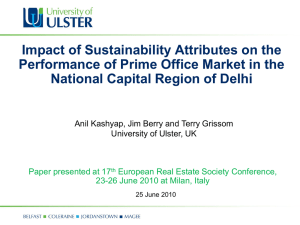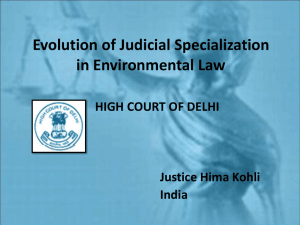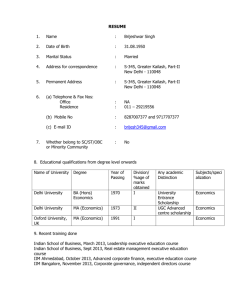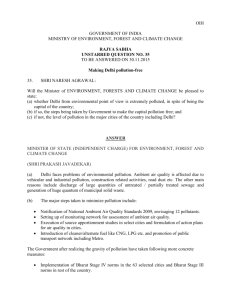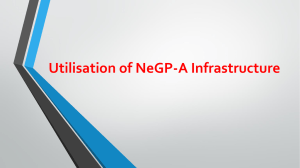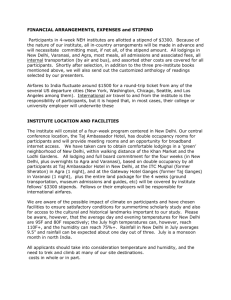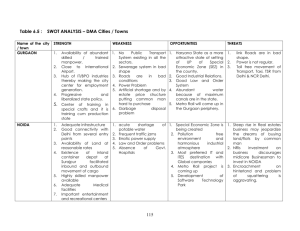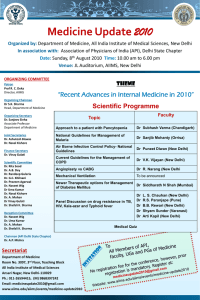Building an energy-efficient India: Case study of Delhi NCR
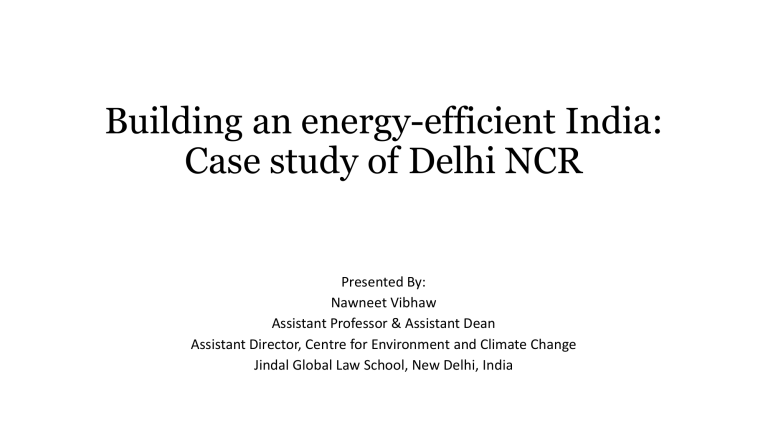
Building an energy-efficient India:
Case study of Delhi NCR
Presented By:
Nawneet Vibhaw
Assistant Professor & Assistant Dean
Assistant Director, Centre for Environment and Climate Change
Jindal Global Law School, New Delhi, India
India: Population Statistics
• Population in 2012: 1.237 Billion
[as per World Bank, US Census Bureau]
• Growth in urban population between 2001-11 – 17.7%
• Percent of urban population – 31.2%
• Highest proportion of urban population – 97.5% [Delhi NCR]
• Total population of Delhi NCR – 21.7 million
States with highest proportion of urban population
Name of the State Percentage of urban population
Total population (in millions)
Goa 62.2
1.459
Mizoram 52.1
1.091
Tamil Nadu
Kerala
Maharashtra
48.4
47.7
45.2
72.15
17.45
112
Density of population (2011)
Country/ State
India
Delhi
Tamil Nadu
Maharashtra
Persons per sq. km.
382
11320
555
365
Why are these figures important?
• The new government had proposed 100 smart cities in its election manifesto
• Most of it is to be constructed along the Delhi-Mumbai Industrial
Corridor (DMIC) [1483 kms. stretch across 5 states]
• Partnership with various countries like Japan, Singapore and France in the pipeline
• Companies like Cisco keen to bag projects
What is a smart-city?
• Economic opportunities
• Mobility (efficient public transportation)
• Clean Environment (minimal pollution levels, maximum recycling, water and waste management)
• Energy Efficiency
• Self-sustainable habitats
• Sustainable economic development
• Job creation
• Minimum impact on environment
• Better quality of life
• Better mobility
• Better healthcare
• Better education
• Clean environment
Efficient public transportation
• Population of Delhi NCR – 21.7 million
• More than 7.5 million vehicles [2012]
• 2.3 million commuters per day in Delhi metro [Feb., 2013]
Clean Environment
• Minimal pollution levels
• Maximum recycling (waste management)
• Water management
Minimum Pollution Levels
• Delhi is the most polluted city in the world (World Health
Organization Study published on May 7, 2014)
• Reasons:
• reliance on fossil fuels such as coal fired power plants
• dependence on private transport motor vehicles
• inefficient use of energy in buildings
• use of biomass for cooking and heating
Waste management
• 85% of the city doesn’t have a formal door-to-door trash pick-up system
• Landfills coming up in neighbourhoods
• Rainwater filtering through it makes groundwater toxic, methane produced pollutes air
• High court intervened, Delhi government maintained its helplessness
Water management
Green Buildings
• Green Buildings make up less than 5 percent of the building market in
India
• Primary rating systems:
• GRIHA (Green Rating for Integrated Habitat Assessment)
• IGBC (Indian Green building Council) which provides for LEED rating
(Leadership in Energy and Environmental Design)
• BEE (The Bureau of Energy Efficiency)
• Government still working on a draft policy to finalise incentives for the sector?!
Example of Godrej Bhavan (Retrofits)
• Electricity costs down by 28 %
• Total electricity usage down 12 %
• Potential 15 year savings of INR 6,980,000
• Largest energy and cost savings came from upgrading the heating, ventilation, and air conditioning (HVAC) system.
• Building management system (BMS) adds by allowing the building operators to monitor, control and modify the building’s energy use, such as through lighting sensors and HVAC systems to control temperature.
So, does the solution lie in building ‘smart cities’ or in (re)building our cities smartly?
